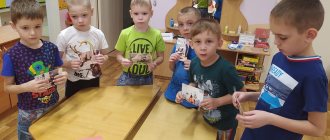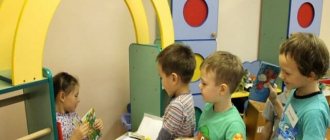Summary of the role-playing game “Bus trip to the zoo”
Summary of the role-playing game “A trip by bus to the zoo” in the senior group.
Target:
systematize children’s existing knowledge and skills about the rules of safe behavior in public places based on the role-playing game “Traveling by Bus to the Zoo.”
Tasks:
continue to develop in children the ability to perform game actions in accordance with the game plan; activate dialogic speech; encourage initiative and independence, strengthen friendly relationships during gaming activities.
Preliminary work:
a series of lessons from the “Safety” series; examination of illustrations on the topic: “Traffic rules”, “Modes of transport”, “Zoo”, “Animals of forests”, “Animals of hot countries”; reading fiction (stories, poems, riddles) S. Marshak “Zoo”, “Children in a Cage”; L. Shevchenko “At the Zoo”; K. Chukovsky “Aibolit”; didactic games: “Attention on the roads”, “Road signs”, “Safe walks”, “Who lives where?”, “Such different animals”, “Zoological lotto”; production of albums “Transport”, “Animals of hot countries”, “Animals of forests”; acquaintance with illustrations by S. Nikolaeva and N. Meshkova from the series “The World Around Us. Beasts"; conversations with children about visiting the zoo in the summer with their parents, about the professions of people working in the zoo; conversations about the characteristics of the animal world and other climatic zones.
Vocabulary work:
freight transport, passenger transport, conductor, driver; veterinarian, zoo, aviary, cashier.
Roles:
bus driver, conductor, cashier, “please”, “thank you”.
Subject-spatial environment:
toys - animals (at least 16 pieces), a designer to build enclosures, a model of a bus, a steering wheel for the driver, a conductor's bag, a model of a ticket office, tickets for the bus and to the zoo, "money".
Methods and techniques:
explanations, story, questions, playing out roles and game situations, riddles, the didactic game “Guess what sign”, the sedentary game “At the Bear in the Forest”.
Progress of the game
A teacher stands at the window with children
-November-late autumn has arrived. It’s very cold outside and everything in nature is preparing for winter. And I would really like to visit a place where you can see forest animals and animals of hot countries, regardless of the weather.
The children suggest going to the zoo. The teacher supports the children's initiative. Everyone together begins to build enclosures from the construction set and place animals (toys) in them, and set up a model of the cash register.
-How can you get to the zoo, maybe by car? (children, he is too small for us)
-But then on a truck? (Children trucks transport goods, not people)
“Project of a role-playing game “Walk in the Zoo” with children of the middle group”
Transcript
1 “Project of a role-playing game “Walk in the Zoo” with children of the middle group” Completed by: Skripka Zoya Nikolaevna, Teacher of MBDOU “Kindergarten 223” g.o. Samara I. Management tasks: 1. a) Expand knowledge about their appearance and floods. b) Develop speech, attention, memory, enrich vocabulary (aviary, animal caretaker). 2. a) Develop gaming skills; ability to develop a plot. b) Stimulate children's creative activity in play. c) Teach children game actions: unification in the game, interaction during the game. 3. a) Cultivate a kind attitude towards animals, love for them and care for them. b) Cultivate friendly, good relationships between children during the game. II. Preparation for the game: 1) preparation plan for the game “Walk in the Zoo” Date Making attributes Enrichment with impressions October - making wallets, - conversation on the topic of money (from paper) “Zoo” - offer to parents - reading K. help in making Chukovsky poster “ Zoo", "Doctor Aibolit", making a sign "Zoo". Sewing a robe and hat for a veterinarian. S.Ya. Marshak “Children in a Cage”, Sh. Nugaev Training in game actions - game situation: learn to give change. - game situation: teach how to buy tickets at the box office - game situation: “Build an enclosure for”
2 November 2) - making tickets (from cardboard) - making badges - making a booklet “Zoo” “Stories at the Zoo”. — invite parents to visit the zoo with their children and watch the animals. — didactic game “Whose Tail”, “Who Lives Where”, “Guess the Animal”. - board games: “Loto Animals” - making and guessing riddles about - depicting with stencils - coloring images - multimedia presentation "Moscow Zoo" - viewing illustrations on the topic - game situation: “Learn to build enclosures for.” — game exercise “Measure the temperature of an animal” — game exercise: “guess the animal” — drawing using stencils. Plot Roles Attributes Game actions Zoo Cashier - Tickets - Sells - Money tickets; — Cash register — Tell us about the new apparatus — Zoo badge; -Warns about the rules of behavior in the zoo; -Issues tickets, receipts and change; Turns of speech - Good afternoon! -Note! -Our zoo features very rare animals. -Be careful and careful! -In our zoo it is forbidden to feed and
3 Zoo bus trip to the Driver Veterinarian Visitors Animal caretaker (teacher) Conductor -Toy car -Figures -Doctor's costume (cap, robe, gloves) -First aid kit -Wallet -Money -Form Related stories -Money -Tickets -Form -Brings to car cages with animals; -Helps to move animals into the enclosure; -Inspection (listening), settling the cell. c - Buys tickets; - Pays; -They ask what’s new and interesting at the zoo; -Takes care of animals; -Feeds them; -Assists the veterinarian; -Sells tickets; -Gives change; -Announces stops; iron! -Get change! -Come to us again! -Attention! Attention! -New animals have arrived. -Please move away from the cage! -Please move away from the cage! Now we will examine ours. All animals are healthy. Thank you all for your concern. -Don't shout! Don't make noise! They don’t feed or put their hands in the cages! -Good afternoon! -Please don't feed! -Thank you! -Please take the ticket, your change. Thank you. -Dear passengers, do not forget to pay your fare on time. -Next stop Thank you.
4 Driver Passengers 3) Scheme of the playing space Veterinary clinic - Car (toy) - Wallet - Money - Bags - Carefully watches the road; -Does not violate traffic rules; -Buy tickets; Paying off; -They ask how to get there; -Dear passengers, please enter the bus. Prepare for the exit in advance. -Thank you for choosing our route. -Please pass me the fare. - Stop at the next stop, please. -Please tell us how to get there. Thank you. Aviaries Cash desk Veterinary hospital Bus III. Progress of the game. 1) Techniques for creating interest in the game. Children sit on chairs that stand in a semicircle. There is a knock on the door, a parent (whom the children do not know) from another group comes. Parent: - Guys, I brought you a poster. Educator: - Thank you!
5 Adult: - Guys, let's take a closer look at it. The children stand around the table and look at her. (On the poster there is an inscription: “Dear children, we invite you to visit our zoo”) Educator: - Where do you think we are invited? (children's answers) - That's right, we are invited to the zoo! Tell me, which of you has been to the zoo? (children's answers) - Who knows what a zoo is? (children's answers). A zoo, as it is known, is a place where animals living on earth today are kept and shown to visitors. — Tell me, who works at the zoo (children’s answers) Answer: cashier, veterinarian, driver, animal care workers and many others. - Guys, look, whose tracks are these? (the teacher draws the children’s attention to animal tracks located on the floor). Educator: - Let's follow them and see where they lead! The teacher and the children line up one after another and, to the music, follow the tracks of the animals in the group and stop in front of the “Zoo” sign. 2) Conspiracy to play Educator: - Guys, where did the tracks lead us? (children's answers) - Correct! And now I invite you to play the game “Zoo”! (The teacher takes on the role of animal caretaker). Each child chooses a role for themselves using the “Wonderful Bag” and prepares a play area. Educator: - Guys, to get to the zoo, we need tickets. Where can we buy them (children's answers). 3) Techniques for teaching game actions Sample showing: buy a ticket at the box office and get change. (Children and the teacher go to the ticket office, receive tickets and go to the zoo).
6 Suddenly an urgent announcement is broadcast over the loudspeaker: - Attention, dear visitors! They urgently brought it to our zoo. But there are no cages (enclosures) for them. They urgently need to be built. Visitor (teacher): - Guys, we will help the animals. We will build spacious enclosures for them (children's answers). Game situation: “Build an enclosure for an animal!” — What will we build the enclosures from? (children's answers). (Children, under the guidance of a teacher, build enclosures from building material to the music). Educator: - Well done! Everyone did it! The enclosures are ready! The car horn sounds. A child in the role of a driver delivers a truck with animals. Educator: - Guys, let's see which ones they brought. (game exercise “Guess the animal”) The teacher makes riddles about, the children guess them with interest. Educator: - Tell me, are these animals domestic or wild? (children's answers). “Now I suggest we show ours to the vet.” Child (the veterinarian examines: appearance, game exercise “Measure the animal’s temperature?” Educator: - Tell me, doctor, are all the animals healthy? (answer) - Then I suggest we place our animals (toys) in enclosures. - Guys, name those that are found in our zoo. (children's answers). Children, if desired, talk about the animal they have chosen. The teacher complements the children's answers. 4) Techniques for maintaining interest in the game To maintain interest in the game, I suggest adding “Photographer at the Zoo” to the game situation. It is proposed to open an ice cream cafe, attractions and a toy store for young visitors to the zoo.
7 5) Techniques for forming relationships in the game We cultivate a friendly attitude towards each other. Guys, don’t forget to share building materials. I remind you that when purchasing a ticket, do not forget to say thank you. Well done everyone! Very spacious enclosures were built. IV. Game over. Educator: Attention! Attention! Our zoo is closing. All visitors are asked to leave the zoo! Guys! You and I will now put all the toys in their places and get ready for a walk. V. Game evaluation. Our walk through the zoo has come to an end! I really liked the way you played. Mashenka was a real veterinarian today and quickly took the temperature of all the animals. Grisha was an excellent driver and delivered the animals to their destination on time. Lera was a polite cashier. She sold a lot of tickets to the zoo. Christina was a well-mannered visitor. She didn't make any noise in the zoo and didn't feed. Oh guys, look what this chest is! (it contains cookies in the form of figures). This is a treat from the zoo residents. They thank us very much for visiting them. The teacher distributes cookies. The children, together with the teacher, follow the same steps back in the group.




